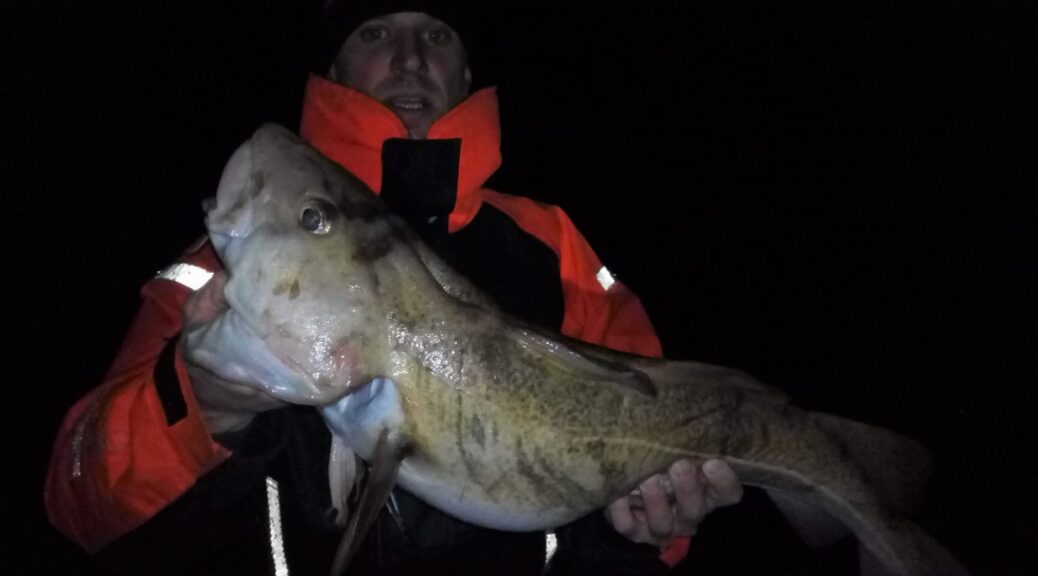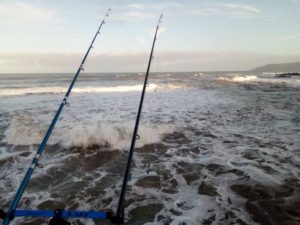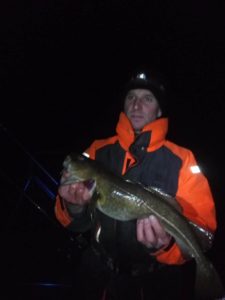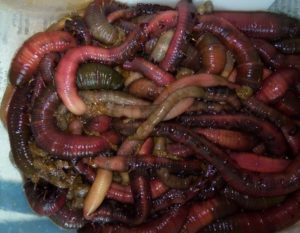
Winter cod fishing – 5 tips to get it right
Winter cod fishing is not for everyone. The more unpleasant the weather is for the angler, the better it is for fishing. Catches are often best when most sane people are in their beds, dreaming of spring. I used to think that camping days on end at the waterside hoping to catch a specimen carp was a kind of madness, now I look back to those carp fishing days and think: luxury. You can’t set up a bivvy on top of the rocks in gale force winds.
Catching big cod from the shore isn’t easy, but when it pays off, it’s unbeatable. Below are the things I wish someone had told me when I started out. I might not catch big fish every time I go out, but these days I rarely blank.
1. Recognise good winter cod fishing conditions

As I explained in my earlier blog post, conditions play a big part in every type of sea fishing, but when it comes to winter cod fishing it’s absolutely crucial to get it right. Bigger cod come closer to the shore during the winter months, but that doesn’t mean they’re always within reach of the shore angler. In calm conditions the fish stay miles offshore, hunting prey fish. They will only move into the shallower waters when there’s plenty of food available there.
Heavy onshore winds stir up the seabed, dislodging shellfish and worms. When there is lots of easy food about, the cod will appear. Ideally these onshore winds continue for several days, bringing more and more cod within casting distance. Right after a storm can be very productive too.
2. Know your winter cod marks

When cod were more plentiful you could probably get away with casting your bait from the first harbour wall, but things are a bit trickier now. Don’t just follow the crowds. When there are lots of anglers at a particular mark it often says more about the nearby parking facilities than anything else. Use those calm pleasant days that are bad for fishing to look for new marks. Go out at low tide, take pictures. Look for fish holding features like gullies, funnel-like bays, deeper holes. Think about where to cast from and how far. On most of the marks I fish precision is a lot more important than distance. Remember that things which are clearly visible in daylight might be unnoticeable at night, so look for landmarks that you can find in the dark.
Safety
Don’t get carried away thinking about fish, consider your personal safety too. If you hook into a good fish, how are you going to land it? What is the safest way to reach the mark, what is your escape route? Will the rocks get slippery when wet? What kind of footwear should you use? I strongly advise against fishing rock marks on your own, especially in winter.
Google Earth Pro
Although it’s best to explore new marks in person, there are limits to what you can see from the shore. That’s when Google Earth can come in handy. You can see the differences in ground and even measure the distance you need to cast. I found this guide to using Google Earth Pro quite useful.
Marks vs. conditions

Every mark fishes differently. Rough seas might throw up bags of fish on one mark while another mark is simply unfishable. The only way to find this out is trial and error. It can be frustrating to walk for miles only to be chased back by a growling sea, but it’s necessary. Make notes to make sure you don’t have to make the same journey in vain again. With enough experience under your belt you will have a mark for all weather conditions. I use the surfer’s site Magicseaweed.com a lot to get an accurate idea of the swell in the area I want to fish.
A rig for every mark
The best rig to use for cod fishing strongly depends on the marks you fish. Rigs that work well on clean ground can be an absolute disaster when the ground is mixed or rough. Every rough ground mark is rough in its own way. It takes time to figure these things out, but nothing is as rewarding as catching fish with a rig you invented yourself. These are the cod rigs I use most of the time.
Always have a rig ready to go
If, after a long quiet period, the cod finally make an appearance, you don’t want to lose any time baiting up. So always have a baited up rig ready to go. With a rig clip tied to your mainline, you can change rigs quickly. Clip off, clip on and you’re out among the fish again. In sea fishing it’s not unusual that all the action happens within half an hour or less. So being prepared can double or triple your catches.
3. Darkness is your friend

When the water is murky, it’s possible to catch big cod during daylight hours, but most of the time catches improve massively once it gets dark. My favourite shallow cod marks haven’t produced a single fish for me during the day. This has nothing to do with feeding behaviour, they simply don’t enter these shallow waters when it’s bright. Don’t just venture out to unknown marks in the dark though. As I mentioned earlier, do your research first so you’re prepared. A good head torch is essential and so are back up batteries. I also always bring a spare light, just in case. The Petzl Tikkina is a good budget option.
4. Source the best winter cod fishing bait – and bring plenty of it

Even if you get everything else right, if you don’t bring the right bait you might as well stay at home. Bigger cod only come close to shore when there’s plenty of food to choose from, so your bait better be up to scratch. What bait catches best can vary from day to day and from mark to mark, but in my neck of the woods you can’t go very wrong with fresh lug. Peeler crab, razor clams, mussel, squid and bluey are all great baits. Cocktails work very well too. I lately had very good catches on a combination of lug and bluey.
Big baits or small baits?
Obviously, the bigger the bait the bigger the scent trail. When I’m casting onto sand I don’t mind sending out big sausage-size baits. Pulley pennel rigs with big hooks up to 7/0, clipped down so they can be sent a long way. But when you’re fishing rough ground, a set up like that is asking for trouble. On snaggy ground I like to put as much bait as I can on a single size 3/0 hook, making sure the hook point is still exposed. With the help of bait elastic you can make baits a lot more compact and condensed. I really like the Sakuma manta extra hooks. Koike wide mouth hooks are a good budget option for marks where you lose a lot of gear.
5. Wear the right clothing
This is really the most important thing when fishing for winter cod. Before buying anything else I would invest in a good flotation suit. I prefer a two piece suit so I can wear just the jacket with waders underneath if necessary. Always make sure you take plenty of extra clothes with you: thick socks, fleeces. Warm base layers like thermal underwear can make a huge difference. If you fish a lot of weed covered rock marks studded boots/ waders are a must.
If you have any winter cod fishing experiences you like to share, please do so in the comment section below.
And if you’d like to receive an email every time I publish a new post, please subscribe to my newsletter. Tight lines!
Disclosure: if you purchase anything using the links in this blog post, I might make a commission. Affiliate programs and affiliations include, but are not limited to, the eBay Partner Network. It doesn’t cost you a penny more to buy via these affiliate links (and you don’t have to use them of course) but it helps me to keep this blog going. Thanks!
2 thoughts on “Winter cod fishing – 5 tips to get it right”
Superb
Thanks!